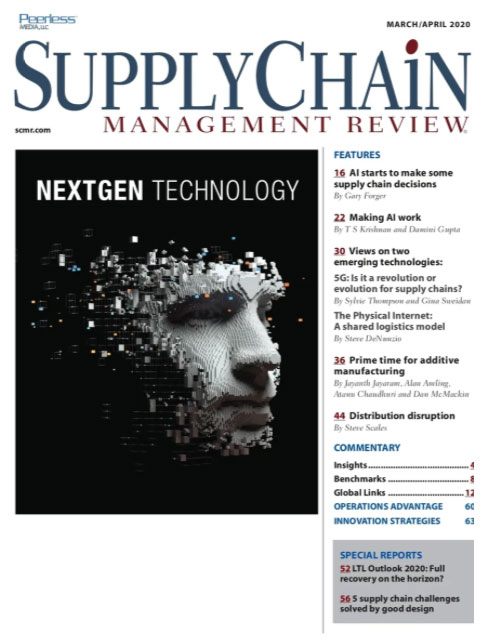Sorry, but your login has failed. Please recheck your login information and resubmit. If your subscription has expired, renew here.
March-April 2020
Are you ready for NextGen technologies? Just the other day, I had the opportunity to tour one of Amazon’s highly automated robotic fulfillment centers. I expected to be dazzled—and I was. But it wasn’t because of the automation. The tour was a reminder that there’s no question that NextGen technologies such as Artificial Intelligence, blockchain, robotics, 3D printing and 5G are going to be the differentiators in tomorrow’s supply chain. The question is: Are you ready? Browse this issue archive.Need Help? Contact customer service 847-559-7581 More options
There has been a lot of hype about the future of Artificial Intelligence (AI). It’s not the first time around the block for AI, and in the past, it didn’t get very far. That leads some people (including me) to wonder: Is now the time that AI will be embraced by corporations to significantly improve business performance? Or, is it “déjà vu all over again?” as the late, great New York Yankee catcher Yogi Berra quipped.
In this column, I’ll discuss my views on the usefulness of AI for business decision-making. They may be counter to what you’re reading in other articles, but they are colored by having watched the development of AI over the years. They also reflect my experiences as a technologist. Throughout my career, I’ve taken the position that technology merely enables business process improvement. Computers should be decision support systems (DSSs), but not necessarily make final decisions; those are best made by managers.
Of course, this doesn’t take away from the fact that many decisions, especially those without significant consequence, can be made without managerial intervention. Take inventory management, for example. An ABC Pareto analysis can help an inventory manager determine the best-stocked items on which to focus his or her time. “A” items may represent the fewest number of SKUs in stock, but they may also generate the largest share of revenue. Thus, they require a lot of a manager’s time to ensure that a computerized inventory management system doesn’t skimp on the amount of stock on the shelves. “B” items, meanwhile, represent a larger share of inventory, but less revenue. For those, the inventory manager can let the computer do most of the inventory management and intervene on an exception basis. Lastly are the “C” items that represent the largest number of SKUs, but the smallest share of revenue. A manager can put those on autopilot and let the system do the work, intervening only in a crisis. In this scenario, AI inventory management technology would be most useful for “C” items; but AI is less useful for “B” items and least useful for the all-important “A” items. Those rely on a manager’s experience.
A brief history of AI
I’ve spent most of my career around computers, and for years I’ve been intrigued by efforts to create systems that can replicate and improve upon human intelligence. IBM, for example, has been researching AI since the 1950s. That work led to the development of a chess-playing computer system known as Deep Blue that beat a reigning world chess champion in 1996; and, more recently, to Watson, a computer system capable of answering questions in natural language. In 2011, Watson beat the two most successful contestants of the TV game show Jeopardy.

This complete article is available to subscribers only.
Log in now for full access or start your PLUS+ subscription for instant access.
SC
MR
Sorry, but your login has failed. Please recheck your login information and resubmit. If your subscription has expired, renew here.
March-April 2020
Are you ready for NextGen technologies? Just the other day, I had the opportunity to tour one of Amazon’s highly automated robotic fulfillment centers. I expected to be dazzled—and I was. But it wasn’t because… Browse this issue archive. Access your online digital edition. Download a PDF file of the March-April 2020 issue.There has been a lot of hype about the future of Artificial Intelligence (AI). It's not the first time around the block for AI, and in the past, it didn't get very far. That leads some people (including me) to wonder: Is now the time that AI will be embraced by corporations to significantly improve business performance? Or, is it “déjà vu all over again?” as the late, great New York Yankee catcher Yogi Berra quipped.
In this column, I'll discuss my views on the usefulness of AI for business decision-making. They may be counter to what you're reading in other articles, but they are colored by having watched the development of AI over the years. They also reflect my experiences as a technologist. Throughout my career, I've taken the position that technology merely enables business process improvement. Computers should be decision support systems (DSSs), but not necessarily make final decisions; those are best made by managers.
Of course, this doesn't take away from the fact that many decisions, especially those without significant consequence, can be made without managerial intervention. Take inventory management, for example. An ABC Pareto analysis can help an inventory manager determine the best-stocked items on which to focus his or her time. “A” items may represent the fewest number of SKUs in stock, but they may also generate the largest share of revenue. Thus, they require a lot of a manager's time to ensure that a computerized inventory management system doesn't skimp on the amount of stock on the shelves. “B” items, meanwhile, represent a larger share of inventory, but less revenue. For those, the inventory manager can let the computer do most of the inventory management and intervene on an exception basis. Lastly are the “C” items that represent the largest number of SKUs, but the smallest share of revenue. A manager can put those on autopilot and let the system do the work, intervening only in a crisis. In this scenario, AI inventory management technology would be most useful for “C” items; but AI is less useful for “B” items and least useful for the all-important “A” items. Those rely on a manager's experience.
A brief history of AI
I've spent most of my career around computers, and for years I've been intrigued by efforts to create systems that can replicate and improve upon human intelligence. IBM, for example, has been researching AI since the 1950s. That work led to the development of a chess-playing computer system known as Deep Blue that beat a reigning world chess champion in 1996; and, more recently, to Watson, a computer system capable of answering questions in natural language. In 2011, Watson beat the two most successful contestants of the TV game show Jeopardy.
 SUBSCRIBERS: Click here to download PDF of the full article.
SUBSCRIBERS: Click here to download PDF of the full article.
SC
MR


Latest Supply Chain News
- Despite American political environment, global geopolitical risks may be easing
- Joseph Esteves named CEO of SGS Maine Pointe
- Employees, employers hold divergent views on upskilling the workforce
- April manufacturing output slides after growing in March
- Q1 sees a solid finish with positive U.S.-bound import growth, notes S&P Global Market Intelligence
- More News
Latest Podcast

 Explore
Explore
Software & Technology News
- Technology’s role in mending supply chain fragility after recent disruptions
- Tech investments bring revenue increases, survey finds
- Survey reveals strategies for addressing supply chain, logistics labor shortages
- AI, virtual reality is bringing experiential learning into the modern age
- Humanoid robots’ place in an intralogistics smart robot strategy
- Tips for CIOs to overcome technology talent acquisition troubles
- More Software & Technology
Latest Software & Technology Resources

Subscribe

Supply Chain Management Review delivers the best industry content.

Editors’ Picks





